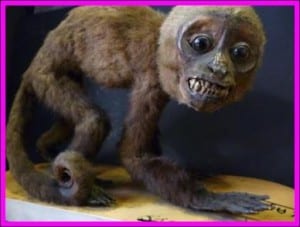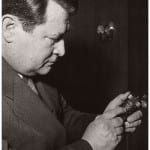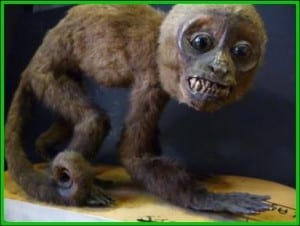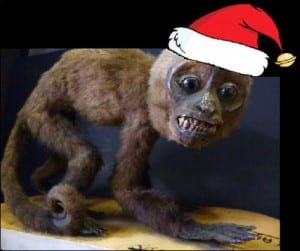Specimen of the Week 173
By Will J Richard, on 2 February 2015
 Hello! It’s Will Richard here again, riding the blog flume that is Specimen of the Week. Last month I gave you an old man with a hole in his head, a family feud and the death of one of our closest cousins. Fun times… So this month I thought I’d have a look at something a little more optimistic. Something full of the promise of spring. A true story of hope, kindness and togetherness… at least that’s how I see it.
Hello! It’s Will Richard here again, riding the blog flume that is Specimen of the Week. Last month I gave you an old man with a hole in his head, a family feud and the death of one of our closest cousins. Fun times… So this month I thought I’d have a look at something a little more optimistic. Something full of the promise of spring. A true story of hope, kindness and togetherness… at least that’s how I see it.
This week’s specimen of the week is…
Underwhelming Fossil Fish of the Month: January 2015
By Mark Carnall, on 30 January 2015
Ladies and gentlemen, boys and girls, children of all ages. The Grant Museum proudly brings to you, the monthly blog series nobody is talking about. The underwhelmingest fossil fish. Occasional photos of the reverse of fossils. The underwhelming fossil fish of the month! This month, as with every month we’ve got exclusive content right here for January 2015. Now, normally I like to keep it low key. A bit hush hush. A bit dress-down. Not too much to get excited over. A little bit, how shall we say, “meh”. However, rifling through the drawers to find this month’s fossil star I was stopped mid-rifle by this specimen. It’s going to be a real challenge to keep this one underwhelming. People of all persuasions and orientations, lock up your partners and significant others because this month we’ve got a real looker of a fossil fish to kick start the year.
I’m excited. Are you excited? Steel yourself for a swoon, here’s this month’s underwhelming fossil fish.
Curt Herzstark and a remarkable machine.
By Nick J Booth, on 27 January 2015
Today is International Holocaust Remembrance Day, and the 70th anniversary of the liberation of Auschwitz-Birkenau by Soviet soldiers. To mark this I thought I would discuss an object from UCL’s collections with a pretty remarkable story. This object not only saved the life of its inventor, but also allowed him to save the lives of others at Buchenwald Concentration Camp.

Curt Herzstark with one of his calculators.
Image from http://curta.li/03_bilder/01_herzstark_1952.html
The Curta calculator is a wonderful machine. It’s was the world’s first handheld mechanical calculator and was used extensively from its invention until the digital calculator took over in the 1960s / 70s. Scientific American called it “the most ingenious calculating machine ever to grace an engineer’s hand” (£ link).
The Curta calculator was invented by Curt Herzstark, born 1904 in Austria, whose family owned a company that made calculating machines and other precision instruments. Read the rest of this entry »
Specimen of the Week 172
By Tannis Davidson, on 26 January 2015
 It’s that time of year when the Christmas tree has been taken down, gifts have been put away, and all holiday food finally consumed. Folk head back to work, kids return to school and everyone gets on with the business of the new year.
It’s that time of year when the Christmas tree has been taken down, gifts have been put away, and all holiday food finally consumed. Folk head back to work, kids return to school and everyone gets on with the business of the new year.
However, for the young (and young-at-heart) January is prime time for the continued enjoyment of new toys and games. Instructions are now understood, multi-piece sets have finally been assembled and a new level of obsessive play-enthusiasm occurs. The post-Christmas clean-up is duly hampered by the constant setting-up and putting-away of various toy sets, 1000 piece puzzles and assorted crafty-painty-arty bits and bobs.
As a tribute to the toy-players and gamers out there, this week’s Specimen of the Week is… Read the rest of this entry »
Specimen of the Week: Week 171
By Mark Carnall, on 19 January 2015
 This week’s Specimen of the Week is one of those animals that is easier to talk about in terms of what it isn’t rather than what it is. In a previous blog post I’ve written about the fun with naming and language that happens when common names meet scientific classifications and how we end up with eels which aren’t eels, crabs which aren’t crabs and the brilliantly named flying lemurs which don’t fly and aren’t lemurs.
This week’s Specimen of the Week is one of those animals that is easier to talk about in terms of what it isn’t rather than what it is. In a previous blog post I’ve written about the fun with naming and language that happens when common names meet scientific classifications and how we end up with eels which aren’t eels, crabs which aren’t crabs and the brilliantly named flying lemurs which don’t fly and aren’t lemurs.
When it comes to fossil organisms there’s often even more fun to be had as it’s very rare that fossil groups are given common names so we end up having to refer to them by what living animals they aren’t or nearly are. This week’s specimen of the week is one of those organisms, I’ll do my best to try to explain what it is below.
This week’s specimen of the week is…
Specimen of the Week: Week 170
By Jack Ashby, on 12 January 2015
 A well known technique in making things desirable is to make them appear unattainable. You want it because you’ve been told you can’t have it. This week I’m employing this strategy to make you fall in love with a specimen. Obviously you can’t have any of our specimens as we’re an accredited museum avowed to care for our collections responsibly, which more or less rules out giving them to the public.
A well known technique in making things desirable is to make them appear unattainable. You want it because you’ve been told you can’t have it. This week I’m employing this strategy to make you fall in love with a specimen. Obviously you can’t have any of our specimens as we’re an accredited museum avowed to care for our collections responsibly, which more or less rules out giving them to the public.
Not only can you not have this week’s Specimen of the Week, you can’t even see it, and there isn’t much more unattainable than that. This isn’t because it’s invisible to the naked eye (though it is small), it’s because it isn’t here.
This week’s Specimen of the Week is… Read the rest of this entry »
The Top Ten Grant Museum Blogs of 2014
By Jack Ashby, on 9 January 2015
Happy New Year!
At this time of year, as well as looking forward to the exciting things we hope to do in the coming year, it is customary to look back at the past one. On Twitter over the past week I’ve been tweeting the best of 2014’s blog – the Top Ten most viewed Grant Museum posts of last year. Looking back, it’s certain that we’ve had a top year in terms of blogging, with 136 posts from Team Grant, and over 100,000 page views across the UCL Museums blog. But what were the best posts?
I’ve announced those ranking at 10 to 2 in the charts, and exclusively revealing here that the most popular post of 2014 is… Read the rest of this entry »
Specimen of the Week: Week 169
By Dean W Veall, on 5 January 2015
 Dean Veall here. A very Happy New Year to all our readers. I thought I would start 2015 BIG, 26ft and 6in BIG to be quite exact. This specimen belongs to the group containing the biggest animals to have ever lived. It is also part of the BIGGEST ever fundraising campaign the Museum has ever run, Bone Idols: Protecting our Iconic Skeletons.
Dean Veall here. A very Happy New Year to all our readers. I thought I would start 2015 BIG, 26ft and 6in BIG to be quite exact. This specimen belongs to the group containing the biggest animals to have ever lived. It is also part of the BIGGEST ever fundraising campaign the Museum has ever run, Bone Idols: Protecting our Iconic Skeletons.
The Bone Idols project involves a series of interventions on 39 of our largely uncollectable specimens which includes re-casing some, completely remonting others and cleaning of these specimens that have been on open display since the 1820’s. This week’s Specimen of the Week is……
Specimen of the Week: Week 168
By Will J Richard, on 29 December 2014
 Hello one and all! Will Richard, here again, wishing you a merry just-after Christmas and before New Year. I expect most of us are still recovering from the festive period. That magical time when friends and family come together in perfect harmony…
Hello one and all! Will Richard, here again, wishing you a merry just-after Christmas and before New Year. I expect most of us are still recovering from the festive period. That magical time when friends and family come together in perfect harmony…
Hmmm…
So, to keep it seasonal, last month I told you all about one of our closest friends (the dog). So this month I’ve got to take a look at some of our closest family.
And to start, let’s be honest. A family row is really part of the whole Holidays thing. We’ve all snapped while caught up in the stress-tivities, but then most of us agree to move forward for the sake of “the others”. But if it is the season to be grumpy, I think I’ve found the biggest family ding-dong ever.
Believe me….
This week’s specimen of the week is…
Specimen of the Week: Week 167
By Tannis Davidson, on 22 December 2014
 Many different animals are associated with Christmastime. There are those with a biblical connection to the birth of Jesus –the animals of the nativity (donkey, ox and sheep) and the camels ridden by the three kings/wise men. There is the Yule goat of Scandinavia (whose ancient origin is connected to the Norse god Thor who rode a chariot drawn by two goats). There are the partridges, turtle doves, French hens, calling birds, geese-a-laying and swans-a-swimming that are mentioned in seasonal song. Of course there are also the reindeer, doves, robins, and wrens associated with yuletide joy, happiness, good fortune, peace and love.
Many different animals are associated with Christmastime. There are those with a biblical connection to the birth of Jesus –the animals of the nativity (donkey, ox and sheep) and the camels ridden by the three kings/wise men. There is the Yule goat of Scandinavia (whose ancient origin is connected to the Norse god Thor who rode a chariot drawn by two goats). There are the partridges, turtle doves, French hens, calling birds, geese-a-laying and swans-a-swimming that are mentioned in seasonal song. Of course there are also the reindeer, doves, robins, and wrens associated with yuletide joy, happiness, good fortune, peace and love.
So without much further ado, let me just add my own animal choice into the mix….this week’s specimen of the week is…
 Close
Close

